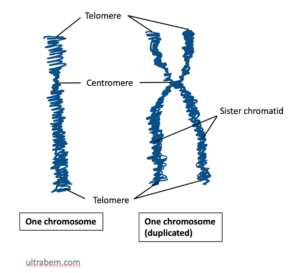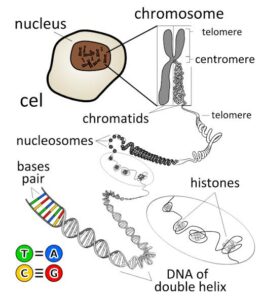Whenever we talk about chromatin, chromatid and chromosome the terms confuse us a lot. We know that all of them are co related forms of genetic material but still confusing. So here we are going to discuss every possible aspect of chromatin vs chromatid and also chromatin vs chromosomes in brief.
Chromatin vs Chromatid
Chromatins are basically combinations of nucleic acids (DNA or RNA) with protein (Histone) substances. Chromatids are identical chromosomal halves joined with each other through the centromere. Let’s have a closer look at comparative study of Chromatin vs Chromatid.
| CharacteristicsChromatinChromatidDefinitionChromatin is a DNA and protein complex found in the nucleus of eukaryotic cells, and plays a major role in DNA packaging mechanisms. | Chromatid is a duplicated half of a replicated chromosome, generally appearing during the cell division process. | |
| Structure | It is lightly condensed Chain of DNA, typically has a thread like structure | It is an identical copy of a chromosome, joined together by centromere. It is a part of the chromosome. |
| Components | Have DNA and histone protein | Have DNA or gene sequences in it. |
| Structural unit | Nucleosome | It is one half of a duplicated chromosome |
| Presence of centromere | It doesn’t contain centromere | It contains centromere |
| Types | There are two types of chromatin, heterochromatin and euchromatin | Two types, sister chromatids and non-sister chromatids |
| Main function | Helps in DNA packaging and transcription regulation process, | It helps to store two copies of genetic information in a cell, to facilitate cell division process. |
| Occurrence | It is seen most of the lifetime specially before cell division | It is seen during cell division, especially at the prophase stage. |
| Role in repair mechanism | Plays important role in DNA repair mechanism | Don’t have any role in DNA repair mechanism |

Chromatin from Wikimedia Commons
Chromatin vs Chromatid summary
From the above comparison table several differences are found. Let’s discuss all the analytical information regarding Chromatin vs Chromatid in brief.
Definition
- Chromatin : Chromatin is a DNA and protein complex found in the nucleus of eukaryotic cells, and plays a major role in DNA packaging mechanisms.
- Chromatid : Chromatid is a duplicated half of a replicated chromosome, generally appearing during the cell division process. When cell division starts, the DNA replicates and the two identical copies with same information are attached together through the centromere region and form chromatids.
Structure
- Chromatin: It is lightly condensed Chain of DNA. Means the DNA or genetic material mostly appears in the nucleus in uncondensed form which looks like thread.
- Chromatid: It is an identical copy of a chromosome, joined together by centromere. It is a part of the chromosome. Two identical joined chromatids form chromosomes.
Components
- Chromatin: The chromatins are typically made up of two components, the DNA substance and histone proteins. The histone proteins in chromatin structure serve as anchors, the DNA substance is wrapped around it.
- Chromatid: The chromatid is the half of a chromosome or the identical copy of a replicated chromosome. Means it contains genetic material DNA or specific nucleotide sequences in it only.
Structural unit
- Chromatin: The structural unit of a chromatin is nucleosome. It contains a DNA segment (generally two turns) wrapped around eight histone protein subunits. These histone units are Known as histone octamers of nucleosomes.
- Chromatid: The Chromatid is none other than just a part or half of a chromosome. That means only nucleotide sequences are considered as the structural unit of it. Different dNTPs form the structure of a DNA, which coiled and formed chromatids.
Presence of centromere
- Chromatin: Chromatin doesn’t contain any centromere in its structure.
- Chromatid: chromatid contains a centromere region. Through this region two chromatids join together and form chromosomes.
Types
- Chromatin: According to the condensation, there are two types of chromatins found in an eukaryotic cell, Heterochromatin and euchromatin. The more coiled chromatin, exhibitie darkly stained structure, it is known as Heterochromatin and the less coiled, lightly stained structure is called euchromatin.
- Chromatid: There are two types of chromatid found, sister chromatids and non sister chromatids. Sister chromatids are identical copies of each other. Non sister chromatids are non-identical to each other.
Main function
- Chromatin : The main function of chromatin is DNA packaging and transcription regulation. The histone proteins help to coil and condense the long chain of DNA, so that the long DNA substance can form chromosomes and take part in cell division, cell repair and cell transcription process.
- Chromatid: The main function of chromatid is two secure two identical copies with the same genetic information. So that when time to divide the acquired genetic information can be transferred from mother to daughter cells.
Occurrence
- Chromatin: Chromatin is seen most of the lifetime specially before cell division process. Before cell division the chromatin starts to coiled and form chromosomes at the beginning of the cell division process.
- Chromatid: chromatin is seen during cell division, especially at the prophase stage. At this phase the DNA starts replicating and one identical copy of a DNA or Chromatid is produced. Later these two strands attach with each other and form chromosomes.
Role in repair mechanism
- Chromatin: Chromatin Plays important role in DNA repair mechanisms.
- Chromatid: Chromatid doesn’t involve DNA repair mechanisms.

Chromatid from Wikimedia Commons
Read on more What chromosomes are made up of: how it is made and detailed facts
Chromatin vs Chromosome
Just like chromatin vs Chromatid we are going to discuss every possible aspect regarding chromatin vs chromosome, this would give us a clear idea about all of them.
Chromatin is a DNA and protein complex found in the nucleus of eukaryotic cells, and plays a major role in DNA packaging mechanisms. Whereas chromosomes are condensed forms of chromatin which take part in the cell division process.
| CharacteristicsChromatinChromosomeDefinitionChromatin is a DNA and histone protein complex found in the nucleus of eukaryotic cells, and plays a major role in DNA packaging mechanismsIn eukaryotic cells Chromosomes are highly condensed, ribbon-like structures having genetic material along with protein substances. It plays a major role in cell division and transfers genetic material from mother to daughter cells. | ||
| Structure | It is a thin, long, thread-like structure, generally 10nm in size. | It is more coiled, thick, generally x like structure, having two chromatid arms attached through centromere. Chromosomes are generally 1 to >20 μm in length. |
| Structural unit | The structural unit of chromatin is nucleosome | Chromosomes are composed of DNA and histone protein complexes, that is Chromatin fibres. |
| CondensationIt is lightly condensed structure, generally 50 times than the normal DNAIt is highly condensed form of Chromatin, generally 10000 times than the normal DNAVisualisationIt can be visible under electron microscopeIt can be visible under light microscopeActivitiesIt actively takes part in the DNA replication and transcription process. | It doesn’t take part in any metabolic activities | |
| Main Function | The main function of chromatin is DNA packaging and transcription regulation | The main function of chromosomes is to take part in cell division and transferring genetic information from mother cell to daughter cells. |
| Occurrence | Chromatin is seen especially in interphase stage | Chromosomes are seen at the time of cell division process |
| Pair | It is unpair | These are generally paired |
Read on more Chromosome Structure: Detailed Explanations
From the analytical study regarding Chromatin vs chromosome, some similarities and differences between both of them are found. Let’s have a closer look at them.
Definition
- Chromatin: Chromatin is a DNA and histone protein complex found in the nucleus of eukaryotic cells, and plays a major role in DNA packaging mechanisms.
- Chromosome : In eukaryotic cells Chromosomes are highly condensed, ribbon-like structures having genetic material along with protein substances. It plays a major role in cell division and transfers genetic material from mother to daughter cells.
Structure
- Chromatin: DNA double helical structure condensed, wrapped around the histone protein to form Chromatin structure. It is a thin, long, thread-like structure, generally 10nm in size.
- Chromosome: Chromatin fibres coiled highly to more Chromosomes. Chromosomes are more coiled, thick, generally a X like structure, having two chromatid arms attached through centromeres. Chromosomes are generally 1 to >20 μm in length.
Structural unit
- Chromatin: The structural unit of chromatin is nucleosome. It contains a DNA segment (generally two turns) wrapped around eight histone protein subunits. These histone units are Known as histone octamers of nucleosomes.
- Chromosome: Chromosomes are composed of DNA and histone protein complexes, that is Chromatin fibres.
Condensation
- Chromatin: Chromatin is a lightly condensed structure, generally 50 times than normal DNA.
- Chromosome: Chromosomes are highly condensed forms of Chromatin, generally 10000 times than normal DNA.
Visualisation
- Chromatin: Chromatin can be only seen under electron microscope.
- Chromosome: Chromosomes can be seen under a light microscope.
Activities
- Chromatin: Chromatin actively takes part in various metabolic activities like DNA replication, RNA transcription and gene expression process. It is also involved in DNA repair mechanisms.
- Chromosome: Chromosome does not take part in any metabolic activity. Not involved in DNA repair mechanisms.
Main Function
- Chromatin: The main function of chromatin is DNA packaging and transcription regulation.
- Chromosome: The main function of chromosomes is to take part in cell division and transferring genetic information from mother cell to daughter cells.
Occurrence
- Chromatin: Chromatin is seen especially in the interphase stage, before cell division starts.
- Chromosome: Chromosomes are seen at the time of cell division process, from metaphase to telophase process.
Pair
- Chromatin: Chromatin is unpaired.
- Chromosome: Chromosomes are generally paired.

Chromatid and Chromosome from Wikimedia Commons
Read on more 7+ Chromosome Function In Plant Cells: Detailed Explanations
As a whole we can say that chromatin, chromatid and chromosomes all are co related forms of genetic material of the cell. From the comparison between chromatin vs chromatid and chromatin vs chromosome, we try to give a clear idea about all of them. Hope this article will be informative to you.
Also Read:
- Butterflies characteristics
- Autotrophs examples
- Staphylococcus bacteria examples
- Allele
- Zygote vs embryo
- Genetic diversity types
- Does transcription occur in the nucleus
- Endotoxin bacteria examples 2
- Difference between animal and plant cell chromosomes
- Amensalism examples

Hello, I am Piyali Das, pursuing my Post Graduation in Zoology from Calcutta University. I am very passionate on Academic Article writing. My aim is to explain complex things in simple way through my writings for the readers.